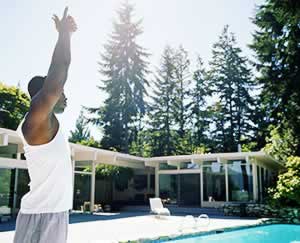Penn Herb Wellness Guide
How Do I Safely Exercise in the Sun?

After a long winter of rain, snow, and ice—and more than a few cancelled workouts—getting outside to move your body is a physical and psychological boon. The sun stimulates production of vitamin D, an essential nutrient for bone development, and serotonin, a neurotransmitter that is partly responsible for our feelings of emotional contentment. So, take advantage of the sun’s rays, but exercise a few precautions and you’ll have an energizing rather than exhausting summer fitness routine.
Timing is everything
Plan your outdoor workouts for early morning or late afternoon. The sun is at its hottest, and its rays are strongest, from 10 a.m. to 4 p.m., putting you at risk for dehydration, sunburn, and heat-related conditions. If the temperature climbs to 90F (32C) or higher, substitute your planned strenuous activity with a more moderate one. Be strategic when choosing your running, walking, and biking routes; look for shaded bike paths, parks, and trails.
Good fashion sense
Start your day by slathering on sunscreen labeled SPF 15 or higher. Sports sunscreens provide additional water- and sweat-resistant protection—especially important for swimmers, kayakers, and other water-bound sports enthusiasts. If exposure to the sun’s skin-damaging rays is your biggest concern, dress in dark-colored clothing to deflect rays. To feel cooler and minimize the heat you feel, opt for lighter colors and less exposure. A tightly woven shirt will keep out some of the vexing UV rays and should cover your back, shoulders, and neck. Make sure your clothing is loose fitting so sweat has a chance to evaporate, keeping you cool and comfortable. Don’t forget your helmet, hat, or bandana. Top off your outfit with UV-protection sunglasses.
Drink up!
Sun mixed with humidity can be a dangerous combination if you add strenuous exercise. Normally a hot body cools itself by sweating. When humidity levels rise, sweat doesn’t evaporate as quickly and your body temperature can spike dangerously. This can lead to heat cramps, heat exhaustion, and, worst-case scenario, heatstroke. Staying hydrated is your best defense. When exercising in the heat, adults of average weight should drink up to 12 cups (2.84 liters) of water a day. People of above-average weight should drink additional liquids. Physically active school-age kids should drink 6 to 8 cups (1.42 to 1.9 liters) a day.
People sweating a lot during prolonged exercise may need to drink electrolyte-containing sports drinks in order to replace depleted sodium and other minerals, which, if not replaced, can cause cramps and other problems.
During your workout, if you feel weak, dizzy, or nauseated—stop! Get out of the sun and hydrate, hydrate, hydrate. Seek out a shady tree and a tall glass of iced lemonade, and put off your workout for another day. This is one situation where procrastination is a good thing.
Occasionally, water can be too much of a good thing: The risk of depleting sodium from drinking lots of liquid without adequate electrolyte replacement can be a serious problem for heavy exercisers. And some people are prone to developing excessive fluid retention by drinking abundantly during prolonged exercise. If you end your exercise feeling waterlogged, or notice that you weigh more at the end of a long workout or competition, see a qualified sports health professional for individualized advice on electrolyte replacement.Copyright 2025 TraceGains, Inc. All rights reserved.


